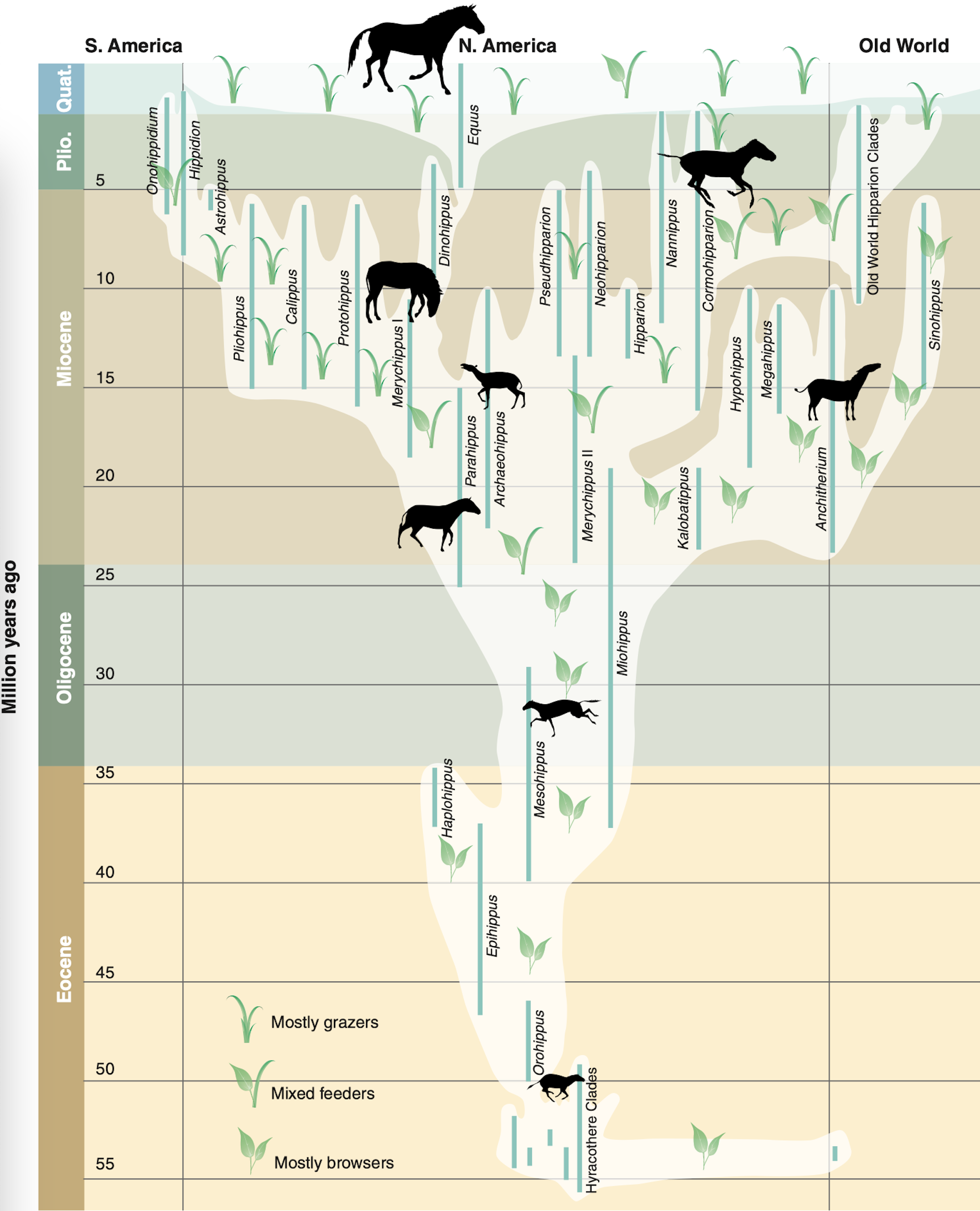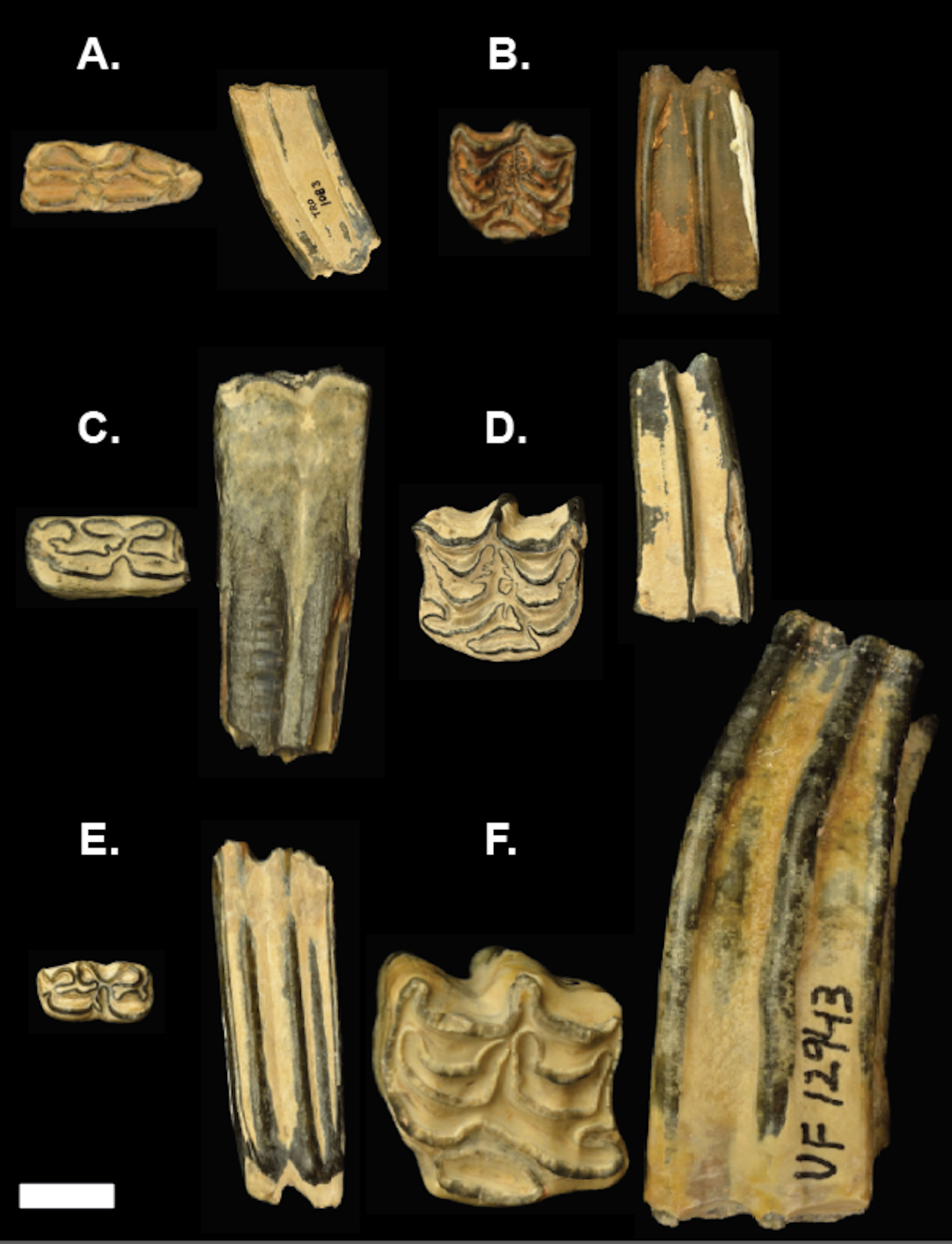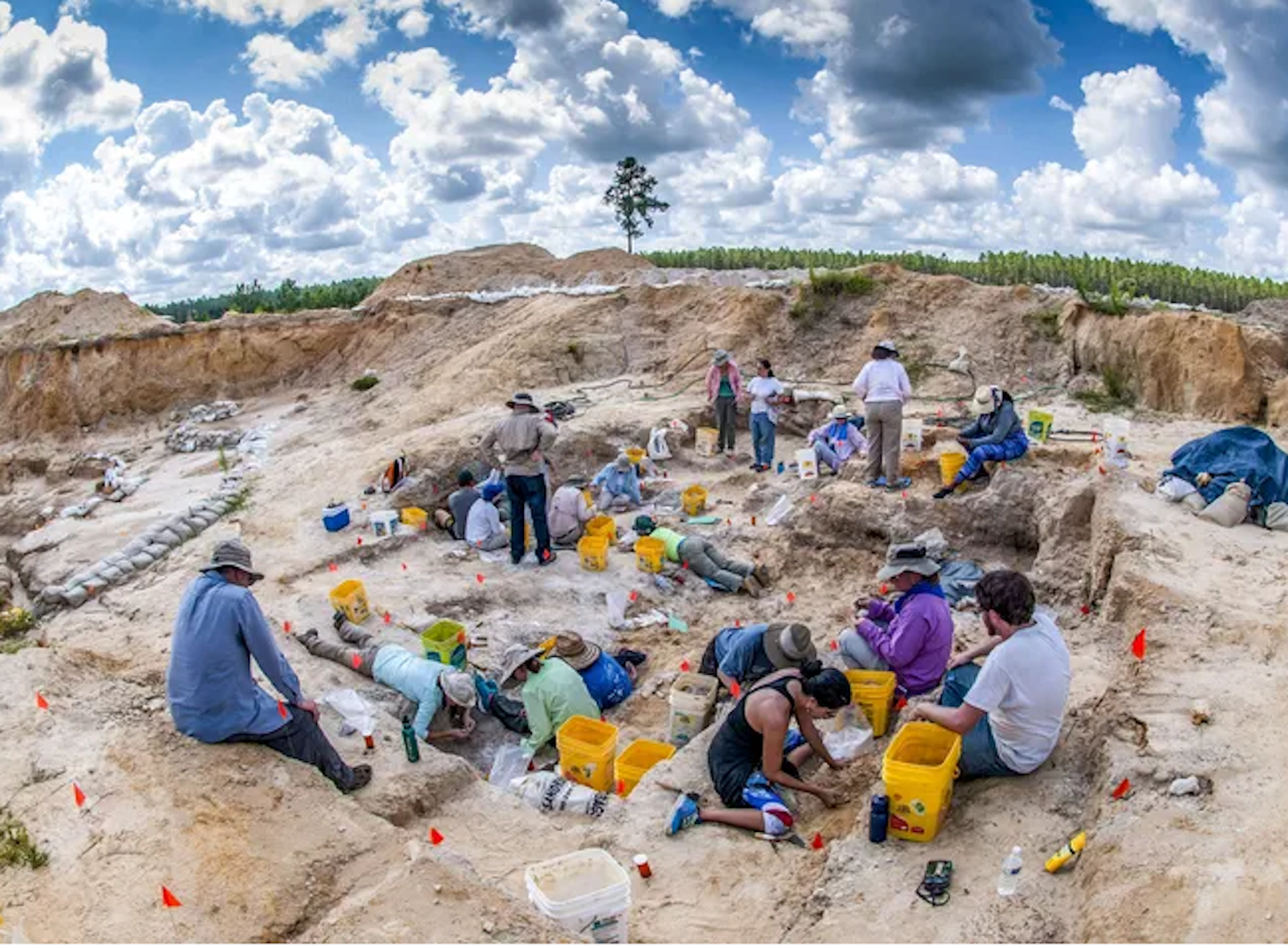Horses lived in the Americas for millions of years – new research helps paleontologists understand the fossils we’ve found and those that are missing from the record
Those few creationists who understand the science hate the record of horse evolution found in the fossil record because it runs counter to their dogma. It shows progressive change over millions of years from a small five-toed herbivore the size of a dog, through increasing size and a progressive reduction in toes to give the modern horse which walks on the tips if a single digit on each foot.
It is a fossil record which gives the lie to creationist assertions that there are no transitional fossils since each stage is clearly intermediate between its ancestors and its descendants. Moreover, most of the evolutionary history of the horse takes place in the very long period of Earth's history from before 'Creation Week' when creationists dogma says Earth was magicked out of nothing by a magic man made of nothing who then magicked all the animals out of dirt, exactly as they are today without ancestors.
And there is more embarrassment for those creationists who like to imagine Stephen J Gould and Nilse Eldredge somehow refuted Darwinian evolution with 'punctuated equilibrium' because the evolution of the horse in North America is a perfect illustration of how Darwinian evolution can produce a local fossil record that looks like a period of 'equilibrium' followed by rapid, even sudden, change in form.
Horses originally evolved in North America before crossing over the land bridge between Alaska and Siberia into Asia where they underwent allopatric speciation and then became extinct in North America during the last Ice Age. The domesticated descendants of the Asian horse were then reintroduced to North America by European colonists during the Middle Ages and subsequently became feral. Any examination of the fossil record will now show what appears to have been a sudden change from the Pliocene horse to the modern horse around 800 years ago because the Darwinian evolution occurred not locally but in Asia, where the fossil record will show what appears to have been the sudden appearance of a Pliocene horse without ancestors and no clear relationship to anything in the local fauna.
Give me a brief description of the evolution of the horse through the different geological ages with the significant anatomical changes, please. The evolution of the horse is a fascinating journey spanning millions of years, characterized by significant anatomical changes. Here's a brief overview:In the following article, reprinted from The Conversation, Stephanie Killingsworth, Ph.D. Student in Geological Sciences, and Bruce J. MacFadden Distinguished Professor and Director of Thompson Earth Systems Institute (TESI), both from the University of Florida, describe the evolution of the horse, with an emphasis on the fossil record. Their article has been reformatted for stylistic consistency:Throughout these geological ages, the evolution of the horse demonstrates a remarkable series of adaptations to changing environments, culminating in the modern equids we see today.
- Eocene Epoch (56-33.9 million years ago):
- The earliest ancestors of modern horses, such as Hyracotherium (also known as Eohippus), appeared during this period.
- These early equids were small, about the size of a small dog, with four toes on their front feet and three toes on their hind feet.
- Their teeth were adapted for browsing on soft foliage.
- Oligocene Epoch (33.9-23 million years ago):
- During this time, horses underwent significant anatomical changes, including the lengthening of their legs and the reduction in the number of toes.
- Genera like Mesohippus and Miohippus emerged, featuring adaptations for grazing on grasses.
- They had larger bodies and more specialized teeth for grinding tougher vegetation.
- Miocene Epoch (23-5.3 million years ago):
- Horses continued to evolve, with genera like Parahippus and Merychippus appearing.
- These horses were larger and more horse-like in appearance, with longer legs and a single functional toe on each foot.
- Their teeth were further adapted for grinding abrasive grasses.
- Pliocene Epoch (5.3-2.6 million years ago):
- Genera like Dinohippus and Hipparion thrived during this period.
- Horses became larger and more similar to modern equids in appearance, with adaptations for open grassland habitats.
- They had high-crowned teeth for grazing on tougher grasses.
- Pleistocene Epoch (2.6 million-11,700 years ago):
- Equus, the genus that includes modern horses, emerged during this time.
- These horses were similar in many ways to modern horses, with further refinements in their anatomy and adaptations for running over long distances.
- They coexisted with early humans and experienced fluctuations in population size due to climate change and human hunting pressure.
On which land masses did these changes take place?
The evolution of horses took place primarily in North America, with some species also evolving in Eurasia. During the early stages of horse evolution, North America was a diverse and fertile continent with various habitats ranging from forests to grasslands, providing ample opportunities for evolutionary experimentation.
As the geological ages progressed and landmasses shifted due to continental drift, horses dispersed to other parts of the world. During the Pleistocene Epoch, which saw the emergence of the genus Equus, horses spread to Eurasia via the Bering Land Bridge, connecting present-day Alaska and Siberia. This land bridge formed during periods of lower sea levels when much of Earth's water was locked up in glaciers.
Therefore, while the initial stages of horse evolution occurred in North America, subsequent evolutionary changes and dispersal led to horses inhabiting various parts of the world, including Eurasia, Africa, and eventually being introduced to other continents by humans.

Horses lived in the Americas for millions of years – new research helps paleontologists understand the fossils we’ve found and those that are missing from the record
People have collected fossil horses throughout North America for centuries.
Stephanie Killingsworth, University of Florida and Bruce J. MacFadden, University of FloridaFlorida Museum/Mary Warrick
Many people assume that horses first came to the Americas when Spanish explorers brought them here about 500 years ago. In fact, recent research has confirmed a European origin for horses associated with humans in the American Southwest and Great Plains.
But those weren’t the first horses in North America. The family Equidae, which includes domesticated varieties of horses and donkeys along with zebras and their kin, is actually native to the Americas. The fossil record reveals horse origins here more than 50 million years ago, as well as their extinction throughout the Americas during the last Ice Age about 10,000 years ago.

Phylogeny, geographic distribution, diet and body sizes of the family Equidae over the past 55 million years.
Horses evolved as ecosystems changed
People have collected fossil horses throughout North America for centuries. Because horse fossils are abundant and widespread across the continent, scientists often point to the long span of the horse family as evidence of long-term evolutionary change.
Paleontologists like us, who study extinct mammals, almost never find complete skeletons. Instead, we focus on durable fossil teeth, which help us understand ancient diets, and fossil limbs, which help clarify how these animals moved.
Horses are eating machines. In the wild today, they primarily feed on grasses that don’t provide much nutrition, and thus they need to consume large quantities to survive. The large teeth of modern horses and their ancestors are adapted primarily for grazing on gritty grasses. They replaced smaller teeth of more primitive horses adapted to browsing on soft leafy vegetation.
We know what horses ate millions of years ago by studying distinctive microscopic scratches, pits and other wear patterns on their teeth that were created as the ancient horses chewed plant foods. And analyses of carbon preserved in fossil teeth show that coexisting horse species ate different plants; some browsed on leaves from bushes and trees, some grazed on grasses, and yet others were mixed feeders.
The change in tooth shape tracks the change in dominant vegetation types in North America, from tropical forests that then gave way to the great expansion of open prairie grasslands. As the climate and flora changed over millions of years, horses shifted from being largely forest-dwelling browsers to largely open-country grazers. Their teeth and feeding patterns adapted to the environment.
Another adaptation is visible on horses’ feet. Modern horses have one hoofed toe on each foot. Many extinct fossil horses – the ancient ancestors of today’s horses – had three toes per foot. The single toe on each elongated foot is good for rapid and sustained running to evade predators and for long-distance seasonal migrations. The more ancient three-toed feet provided stability on unstable or wet ground. The adaptation from three toes to one was likely in response to changing habitats.
But even as the environment changed, one distinct species didn’t completely replace another overnight. The fossil record in North America documents periods millions of years ago when multiple horse species coexisted on the ancient landscapes. Species were of different sizes and had teeth equipped for munching different plants, so they weren’t competing directly for the same foods. Different habitats within these ancient ecosystems likely had some species more adapted to forests and others more adapted to grasslands.

An artist’s rendition of species that lived in Florida during the Pliocene epoch, a time of global cooling 5.3 million to 2.6 million years ago.
Carl Buell/Florida Museum
Paleontologists have been collecting horse fossils in Florida for over 125 years. The Florida Museum of Natural History at the University of Florida, where we work, has more than 70,000 fossil horse specimens from more than a thousand locations across the state.

Each of the six fossil horse species (A-F) found in Florida have distinct teeth. Scale bar = 1 centimeter.
Although six horse species are known elsewhere in Florida, we have only found four so far at Montbrook. This smaller number of horse species perplexed us, so we decided to investigate. Did the two “missing” horse species truly not live at Montbrook, or have scientists simply not discovered their fossil remains yet?
We designed a theoretical model that compares Montbrook, with only four horse species, to other fossil sites in Florida that contain all six. Using a statistical technique that scientists call “bootstrapping,” our computer essentially simulated continued fossil collecting over time. We generated 1,000 theoretical fossil collection events based on the fossil species counts from the sites where all six are present, to predict the probability of collecting the species that are currently missing at Montbrook.
Results from our simulation show that the two missing horse species at Montbrook were absent for different reasons. One of the horses is likely to be truly absent; the other may still be discovered with further excavation.
Probing ‘gaps’ in the fossil record
Knowing a species is absent is just as important as knowing when one is present at a fossil site. Absences may be indicators of underlying ecological and biological drivers changing population dynamics. Coupled with other types of analyses, researchers can apply this kind of predictive modeling across many fossil species and ancient landscapes.
Ever since Charles Darwin proposed his theory of evolution, scientists have known that the fossil record is incomplete, resulting in gaps in our knowledge of the ancient past and evolutionary change. Paleontologists are challenged to explain these gaps, including which species were or were not present at particular fossil sites.
Gaps can result from certain materials, such as teeth and shells, which are often more durable than porous bone, fossilizing better than others. Likewise, different chemical conditions during fossilization, and even the amount of time spent collecting fossils at a particular site, can contribute to the lack of knowledge.
Fortunately, fossil horse teeth preserve quite well and are commonly found. As new discoveries are made, such as those from our ongoing excavations in Florida, they’ll help clarify and narrow gaps in the fossil record.
Stephanie Killingsworth, Ph.D. Student in Geological Sciences, University of Florida and Bruce J. MacFadden, Distinguished Professor and Director of Thompson Earth Systems Institute (TESI), University of Florida
This article is republished from The Conversation under a Creative Commons license. Read the original article.
What Makes You So Special? From The Big Bang To You
How did you come to be here, now? This books takes you from the Big Bang to the evolution of modern humans and the history of human cultures, showing that science is an adventure of discovery and a source of limitless wonder, giving us richer and more rewarding appreciation of the phenomenal privilege of merely being alive and able to begin to understand it all.
Available in Hardcover, Paperback or ebook for Kindle
Ten Reasons To Lose Faith: And Why You Are Better Off Without It
This book explains why faith is a fallacy and serves no useful purpose other than providing an excuse for pretending to know things that are unknown. It also explains how losing faith liberates former sufferers from fear, delusion and the control of others, freeing them to see the world in a different light, to recognise the injustices that religions cause and to accept people for who they are, not which group they happened to be born in. A society based on atheist, Humanist principles would be a less divided, more inclusive, more peaceful society and one more appreciative of the one opportunity that life gives us to enjoy and wonder at the world we live in.
Available in Hardcover, Paperback or ebook for Kindle







No comments :
Post a Comment
Obscene, threatening or obnoxious messages, preaching, abuse and spam will be removed, as will anything by known Internet trolls and stalkers, by known sock-puppet accounts and anything not connected with the post,
A claim made without evidence can be dismissed without evidence. Remember: your opinion is not an established fact unless corroborated.